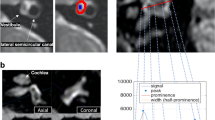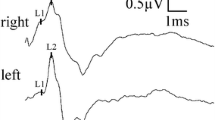Abstract
Objectives
The aim of this study was to shorten the 4-h delay between the intravenous administration of gadolinium and MRI acquisition for hydrops evaluation using an optimized 3D-FLAIR sequence in patients with Menière’s disease.
Methods
This was a single-center prospective study including 29 patients (58 ears), recruited between November 2020 and February 2021. All patients underwent a 3-T MRI with an optimized 3D-FLAIR sequence without contrast then at 1 h, 2 h, and 4 h after intravenous administration of gadobutrol. The signal intensity ratio was quantitatively assessed with the region of interest method. We also evaluated the volume of endolymphatic structures (saccule, utricle) then the presence of endolymphatic hydrops and blood-labyrinthine barrier impairment at each acquisition time.
Results
For all ears, the signal intensity ratio was significantly non-inferior at 2 h compared to 4 h, with a mean geometric signal intensity ratio at 0.83 (95% CI: 0.76 to 0.90, one-sided p < .001 for non-inferiority at −30% margin). Mean volume equivalence of saccule and utricle between 2 and 4 h was proven at a ± 0.20 standardized deviation equivalence margin. Intra-rater agreements (Cohen’s kappa) were all greater than 0.90 for all endolymphatic hydrops location and blood-labyrinthine-barrier impairment between the 2- and 4-h assessments.
Conclusions
We demonstrated that using an optimized 3D-FLAIR sequence we could shorten the acquisition from 4 to 2 h with a high reliability for the diagnosis of endolymphatic hydrops and blood-labyrinthine-barrier impairment.
Clinical trial registration
Clinical trial no: 38RC15.173
Key Points
• Magnetic resonance imaging with delayed 3D-FLAIR sequences allows the diagnosis of endolymphatic hydrops in patients with definite Menière’s disease.
• An optimized 3D-FLAIR sequence with a long TR of 16000 ms and a constant flip angle allows for reducing the delay between intravenous injection of gadobutrol and MRI acquisition from 4 to 2 h to diagnose endolymphatic hydrops.
• Reducing this delay between intravenous injection and MRI acquisition could have implications for clinical practice for both patients and imaging departments.




Similar content being viewed by others
Abbreviations
- BLB:
-
Blood-labyrinthine-barrier
- CNR:
-
Contrast-to-noise ratio
- EH:
-
Endolymphatic hydrops
- FOV:
-
Field of view
- GRAPPA:
-
Generalized auto calibrating partially parallel acquisition
- IC:
-
Confidence interval
- ICC:
-
Intraclass correlation coefficient
- MD:
-
Meniere disease
- Nex:
-
Number of excitations
- SD:
-
Standard deviation
- SIR:
-
Signal intensity ratio
- SMD:
-
Standardized mean difference
- TE:
-
Echo time
- TI:
-
Time inversion
- TR:
-
Repetition time
- κ:
-
Cohen’s kappa
References
Pyykkö I, Nakashima T, Yoshida T, Zou J, Naganawa S (2013) Ménière’s disease: a reappraisal supported by a variable latency of symptoms and the MRI visualisation of endolymphatic hydrops. BMJ Open 3:e001555
Hallpike CS Observations on the Pathology of Meniere’s Syndrome. Proceedings of the Royal Society of Medicine. (n.d.) 30
Eliezer M, Attyé A, Toupet M, Hautefort C (2021) Imaging of endolymphatic hydrops: a comprehensive update in primary and secondary hydropic ear disease. J Vestibular Res 31:261–268
Eliezer M, Poillon G, Maquet C et al (2019) Sensorineural hearing loss in patients with vestibular schwannoma correlates with the presence of utricular hydrops as diagnosed on heavily T2-weighted MRI. Diagn Interv Imaging. 100:259–268
Counter SA, Bjelke B, Klason T, Chen Z, Borg E (1999) Magnetic resonance imaging of the cochlea, spiral ganglia and eighth nerve of the guinea pig. Neuroreport 10:473–479
Niyazov DM, Andrews JC, Strelioff D, Sinha S, Lufkin R (2001) Diagnosis of endolymphatic hydrops in vivo with magnetic resonance imaging. Otol Neurotol 22:8113–8817
Naganawa S, Komada T, Fukatsu H, Ishigaki T, Takizawa O (2006) Observation of contrast enhancement in the cochlear fluid space of healthy subjects using a 3D-FLAIR sequence at 3 Tesla. Eur Radiol. 16:733–737
Naganawa S, Suzuki K, Yamazaki M, Sakurai Y, Ikeda M (2014) Time course for measuring endolymphatic size in healthy volunteers following intravenous administration of gadoteridol. Magn Reson Med Sci. 13:73–80
Eliezer M, Poillon G, Gillibert A et al (2018) Comparison of enhancement of the vestibular perilymph between gadoterate meglumine and gadobutrol at 3-Tesla in Meniere’s disease. Diagn Interv Imaging. 99:271–277
Nahmani S, Vaussy A, Hautefort C et al (2020) Comparison of enhancement of the vestibular perilymph between variable and constant flip angle-delayed 3D-FLAIR sequences in Menière disease. AJNR Am J Neuroradiol. 41:706–711
Osman S, Hautefort C, Attyé A et al (2022) Increased signal intensity with delayed post contrast 3D-FLAIR MRI sequence using constant flip angle and long repetition time for inner ear evaluation. Diagn Interv Imaging 103(4):225–229. https://doi.org/10.1016/j.diii.2021.10.003
Lopez-Escamez JA, Carey J, Chung WH et al (2015) Diagnostic criteria for Menire's disease. J Vest Res 25(1):1–7
Tagaya M, Teranishi M, Naganawa S et al (2010) 3 Tesla magnetic resonance imaging obtained 4 hours after intravenous gadolinium injection in patients with sudden deafness. Acta Otolaryngol 130:665–669
Kahn L, Hautefort C, Guichard JP et al (2020) Relationship between video head impulse test, ocular and cervical vestibular evoked myogenic potentials, and compartmental magnetic resonance imaging classification in menière’s disease. Laryngoscope. 130:444–452
Naganawa S, Yamazaki M, Kawai H, Bokura K, Sone M, Nakashima T (2012) Visualization of endolymphatic hydrops in Ménière’s disease after single-dose intravenous gadolinium-based contrast medium: timing of optimal enhancement. Magn Reson Med Sci. 11:43–51
Shimono M, Teranishi M, Yoshida T et al (2013) Endolymphatic hydrops revealed by magnetic resonance imaging in patients with acute low-tone sensorineural hearing loss. Otol Neurotol. 34:1241–1246
Nakashima T, Naganawa S, Teranishi M et al (2010) Endolymphatic hydrops revealed by intravenous gadolinium injection in patients with Ménière’s disease. Acta Otolaryngol. 130:338–343
Rohrer M, Bauer H, Mintorovitch J, Requardt M, Weinmann HJ (2005) Comparison of magnetic properties of MRI contrast media solutions at different magnetic field strengths. Invest Radiol. 40:715–724
Naganawa S, Kawai H, Taoka T, Sone M (2017) Improved HYDROPS: Imaging of Endolymphatic Hydrops after Intravenous Administration of Gadolinium. Magn Reson Med Sci. 16:357–361
Naganawa S, Kawai H, Taoka T, Sone M (2019) Improved 3D-real inversion recovery: a robust imaging technique for endolymphatic hydrops after intravenous administration of gadolinium. Magn Reson Med Sci. 18:105–108
Merchant SN, Adams JC, Nadol JB (2005) Pathophysiology of Meniere’s syndrome: are symptoms caused by endolymphatic hydrops? Otol Neurotol. 26:74–81
Yamazaki M, Naganawa S, Kawai H, Nihashi T, Fukatsu H, Nakashima T (2009) Increased signal intensity of the cochlea on pre- and post-contrast enhanced 3D-FLAIR in patients with vestibular schwannoma. Neuroradiology 51:855–863
Pakdaman MN, Ishiyama G, Ishiyama A et al (2016) Blood-labyrinth barrier permeability in Menière disease and idiopathic sudden sensorineural hearing loss: findings on delayed postcontrast 3D-FLAIR MRI. AJNR Am J Neuroradiol. 37:1903–1908
Tagaya M, Yamazaki M, Teranishi M et al (2011) Endolymphatic hydrops and blood-labyrinth barrier in Ménière’s disease. Acta Otolaryngol. 131:474–479
Morita N, Kariya S, Farajzadeh Deroee A et al (2009) Membranous labyrinth volumes in normal ears and Ménière disease: a three-dimensional reconstruction study: Volumes of Membranous Labyrinth. Laryngoscope. 119:2216–2220
Naganawa S, Yamazaki M, Kawai H, Bokura K, Sone M, Nakashima T (2013) Visualization of endolymphatic hydrops in Ménière’s disease after intravenous administration of single-dose gadodiamide at 1.5T. Magn Reson Med Sci. 12:137–139
Kenis C, Crins T, Bernaerts A, Casselman J, Foer BD (2021) Diagnosis of Menière’s disease on MRI: feasibility at 1.5 Tesla. Acta Radiol. https://doi.org/10.1177/02841851211016478
Funding
The authors state that this work has not received any funding.
Author information
Authors and Affiliations
Corresponding author
Ethics declarations
Guarantor
The scientific guarantor of this publication is Michaël Eliezer.
Conflict of interest
One of the authors (Alexis Vaussy) of this manuscript is an employee of Siemens Healthcare. The remaining authors declare no relationships with any companies whose products or services may be related to the subject matter of the article.
Statistics and biometry
One of the authors has significant statistical expertise.
Informed consent
Written informed consent was obtained from all subjects (patients) in this study.
Ethical approval
Institutional Review Board approval was obtained.
Methodology
• prospective
• diagnostic or prognostic study
• performed at one institution
Additional information
Publisher’s note
Springer Nature remains neutral with regard to jurisdictional claims in published maps and institutional affiliations.
Rights and permissions
About this article
Cite this article
Barlet, J., Vaussy, A., Ejzenberg, Y. et al. Optimized 3D-FLAIR sequences to shorten the delay between intravenous administration of gadolinium and MRI acquisition in patients with Menière’s disease. Eur Radiol 32, 6900–6909 (2022). https://doi.org/10.1007/s00330-022-08889-y
Received:
Revised:
Accepted:
Published:
Issue Date:
DOI: https://doi.org/10.1007/s00330-022-08889-y




